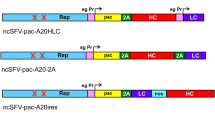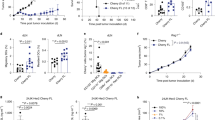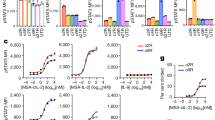Abstract
A fusion protein containing a B cell lymphoma idiotype (Id) and granulocyte–macrophage colony-stimulating factor (GM-CSF) is a potent stimulator of tumor immunity. In three different tumor models we show that immunization with autologous lymphoma cells that have been engineered to express the Id in the context of GM-CSF is much more effective than immunization with an equivalent dose of the purified protein. The lymphoma Id could be modified by introducing the GM-CSF gene into the immunoglobulin (Ig) heavy chain locus via gene targeting. This approach circumvents the isolation of the rearranged immunoglobulin variable genes from the tumor and the preparation of tumor-specific vector constructs. The low production of Id/GM-CSF fusion proteins by transfected cells, which is a major obstacle in the use of purified fusion proteins for immunotherapy, is due to the presence of the cytokine gene in the immunoglobulin locus. Low production, however, is not limiting in the cell-based setting, because upon in vivo administration of the modified autologous cells, even minute expression levels are sufficient to induce tumor immunity.
This is a preview of subscription content, access via your institution
Access options
Subscribe to this journal
Receive 12 print issues and online access
$259.00 per year
only $21.58 per issue
Buy this article
- Purchase on Springer Link
- Instant access to full article PDF
Prices may be subject to local taxes which are calculated during checkout




Similar content being viewed by others
References
Coulie PG . Human tumour antigens recognized by T cells: new perspectives for anti-cancer vaccines? Mol Med Today 1997 3: 261–268
Boon T, van der Bruggen P . Human tumor antigens recognized by T lymphocytes J Exp Med 1996 183: 725–729
Tsioulias GJ et al. Expression of HLA class I antigens in sporadic adenomas and histologically normal mucosa of the colon Cancer Res 1993 53: 2374–2378
Chen L et al. Costimulation of antitumor immunity by the B7 counterreceptor for the T lymphocyte molecules CD28 and CTLA-4 Cell 1992 71: 1093–1102
Schwartz RH . A cell culture model for T lymphocyte clonal anergy Science 1990 248: 1349–1356
Borden EC, Sondel PM . Lymphokines and cytokines as cancer treatment. Immunotherapy realized Cancer 1990 65: 800–814
Schiller JH et al. A direct comparison of immunological and clinical effects of interleukin-2 with and without interferon-α in humans Cancer Res 1993 53: 1286–1292
Schmidt-Wolf G, Schmidt-Wolf IGH . Cytokines and clinical gene therapy Eur J Immunol 1995 25: 1137–1140
Colombo MP, Forni G . Cytokine gene transfer in tumor inhibition and tumor therapy: where are we now? Immunol Today 1994 15: 48–51
Tepper RI, Mule JJ . Experimental and clinical studies of cytokine gene-modified tumor cells Hum Gene Ther 1994 5: 153–164
Dranoff G et al. Vaccination with irradiated tumor cells engineered to secrete murine granulocyte-macrophage colony-stimulating factor stimulates potent, specific and long-lasting anti-tumor immunity Proc Natl Acad Sci USA 1993 90: 3539–3543
Steinmann RM . The dendritic cell system and its role in immunogenicity Annu Rev Immunol 1991 9: 271–296
Levitsky HI et al. Immunization with granulocyte–macrophage colony-stimulating factor-transduced, but not B7–1-transduced, lymphoma cells primes idiotype-specific T cells and generates potent systemic antitumor immunity J Immunol 1996 156: 3858–3865
Campbell MJ et al. Idiotype vaccination against murine B cell lymphoma. Humoral and cellular requirements for the full expression of antitumor immunity J Immunol 1990 145: 1029–1036
George AJT, Folkard SG, Hamblin TJ, Stevenson FK . Idiotypic vaccination as a treatment for a B cell lymphoma J Immunol 1988 141: 2168–2174
Campbell MJ et al. Idiotype vaccination against murine B cell lymphoma. Humoral and cellular responses elicited by tumor-derived immunoglobulin M and its molecular subunits J Immunol 1987 139: 2825–2833
Brown SL, Miller RA, Levy R . Antiidiotype antibody therapy of B-cell lymphoma Semin Oncol 1989 16: 199–210
Kwak LW et al. Induction of immune responses in patients with B-cell lymphoma against the surface-immunoglobulin idiotype expressed by their tumors New Engl J Med 1992 327: 1209–1215
Tao M-H, Levy R . Idiotype/granulocyte–macrophage colony-stimulating factor fusion protein as a vaccine for B-cell lymphoma Nature 1993 362: 755–758
Mocikat R et al. Unaltered immunoglobulin expression in hybridoma cells modified by targeting of the heavy chain locus with an integration vector Immunology 1995 84: 159–163
Kardnal C et al. Integration vectors for antibody chimerization by homologous recombination in hybridoma cells Eur J Immunol 1995 25: 792–797
Mocikat R, Kütemeier G, Hoffmann-Fezer G, Thierfelder S . A mouse model for the preclinical evaluation of immunosuppressive effector functions of human isotypes. The human IgG1 isotype is superior to IgG3 Transplantation 1994 57: 405–411
Chace JH, Cowdery JS, Field EH . Effect of anti-CD4 on CD4 subsets. I. Anti-CD4 preferentially deletes resting, naive CD4 cells and spares activated CD4 cells J Immunol 1994 152: 405–412
Syrengelas AD, Chen TT, Levy R . DNA immunization induces protective immunity against B-cell lymphoma Nature Med 1996 2: 1038–1041
Mocikat R, Selmayr M, Thierfelder S, Lindhofer H . Trioma-based vaccination against B-cell lymphoma confers long-lasting tumor immunity Cancer Res 1997 57: 2346–2349
Stanley E et al. The structure and expression of the murine gene encoding granulocyte–macrophage colony-stimulating factor: evidence for utilisation of alternative promoters EMBO J 1985 4: 2569–2573
Mocikat R, Kardinal C, Klobeck HG . Differential interactions between the immunoglobulin heavy chain μ intron and 3′ enhancer Eur J Immunol 1995 25: 3195–3198
Karasuyama H, Kudo A, Melchers F . The proteins encoded by the VpreB and λ5 pre-B cell-specific genes can associate with each other and with μ heavy chain J Exp Med 1990 172: 969–972
Bergman Y, Haimovich J . Characterization of a carcinogen-induced murine B lymphocyte cell line of C3H/eB origin Eur J Immunol 1977 7: 413–417
Kim KJ et al. Establishment and characterization of BALB/c lymphoma lines with B cell properties J Immunol 1979 122: 549–554
Laskov R, Scharff MD . Synthesis, assembly and secretion of gamma globulin by mouse myeloma cells. I. Adaptation of the Merwin plasma cell tumor-11 to culture, cloning and characterization of gamma globulin subunits J Exp Med 1970 131: 515–541
Shulman M, Wilde CD, Köhler G . A better cell line for making hybridomas secreting specific antibodies Nature 1978 276: 269–270
Demanet C et al. Treatment of murine B cell lymphoma with bispecific monoclonal antibodies (anti-idiotype × anti-CD3) J Immunol 1991 147: 1091–1097
Naparstek E et al. Induction of growth alterations in factor-dependent hematopoietic progenitor cell lines by cocultivation with irradiated bone marrow stromal cell lines Blood 1986 67: 1395–1403
Reinecke K, Mysliwietz J, Thierfelder S . Single as well as pairs of synergistic anti-CD4 + CD8 antibodies prevent graft-versus-host disease in fully mismatched mice Transplantation 1994 57: 458–461
Kremmer E et al. Neutralization of immunosuppression by antibodies against variable as well as constant regions of monoclonal anti-Thy-1 xenoantibodies and their ability to be suppressed by initial T cell depletion Transplantation 1989 47: 641–646
Author information
Authors and Affiliations
Rights and permissions
About this article
Cite this article
Selmayr, M., Strehl, J., Kremer, JP. et al. Induction of tumor immunity by autologous B lymphoma cells expressing a genetically engineered idiotype. Gene Ther 6, 778–784 (1999). https://doi.org/10.1038/sj.gt.3300875
Received:
Accepted:
Published:
Issue Date:
DOI: https://doi.org/10.1038/sj.gt.3300875
Keywords
This article is cited by
-
Specific targeting of whole lymphoma cells to dendritic cells ex vivo provides a potent antitumor vaccine
Journal of Translational Medicine (2007)
-
Epstein–Barr virus vector-mediated gene transfer into human B cells: potential for antitumor vaccination
Gene Therapy (2006)



